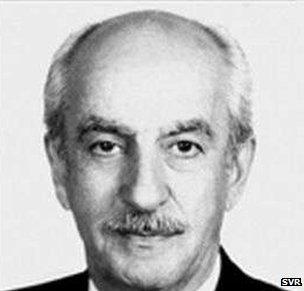Soviet spying legend Gevork Vartanian dies at 87
- Published

Vartanian was active as a spy from his teenage years
Legendary Soviet spy Gevork Vartanian, who helped foil a Nazi plot to kill Allied leaders in Tehran during World War II, has died in Moscow aged 87.
Operating in Tehran during World War II, he tracked German commandoes who had arrived to attack a summit attended by Stalin, Roosevelt and Churchill.
Realising they were being followed, the Germans called off the attack.
He also managed to infiltrate British intelligence, exposing a network of secret agents in the USSR.
Vartanian did so by getting accepted on a British training course for spies in Tehran.
His wife was a Soviet spy, too, and after the war they worked as a team for the next 30 years.
Gevork Vartanian retired from Russia's foreign intelligence service, the SVR, in 1992.
Russian President Dmitry Medvedev described him as a true patriot and a remarkable person.
Father's footsteps
Vartanian was born on 17 February 1924 in the south Russian city of Rostov-on-Don, into the family of an Iranian national of Armenian extraction.
In 1930, the family moved to Tehran where the father, Andrei, served as a Soviet agent under a business cover.
Following his father, Gevork became a Soviet agent in 1940 at the age of 16.
Codenamed Amir, his task was to root out German and British spies.
British intelligence was training Russian-speakers in Tehran to serve as spies in Soviet Central Asia and the Caucasus.
Vartanian underwent training, then passed on information on the British school to Moscow.
As a result, British-trained spies sent to the USSR were either captured or recruited as double agents.
Camels and guns
In the winter of 1943, the leaders of the USSR, US and Britain met for a summit in Tehran to decide their strategy for victory over Hitler.
It was held in the Soviet embassy after Stalin alerted Roosevelt to a Nazi plot to assassinate them.
At the time, Tehran was full of refugees from war-torn Europe, and Nazi agents were active among some 20,000 Germans living in Iran, Vartanian recalled in an interview for Russia's Ria-Novosti news agency, external in 2007.
He recounted how he had tracked down Germans, including field station chief Franz Meyer who disappeared.
When finally located, Meyer was found to have "grown a beard and dyed it, and was working as a grave-digger at an Armenian cemetery".
From 1940-41, Vartanian and his colleagues reportedly exposed 400 people linked to German intelligence.
In 1943, the Soviet agents located the landing party sent by the Nazis for the assassination plot, six radio operators who were "travelling by camel and loaded with weapons".
"We arrested all the members... and made them make contact with enemy intelligence under our supervision," Vartanian said.
"We deliberately gave a radio operator an opportunity to report the failure of the mission."
Reflecting on his 45 years in espionage, much of it alongside his wife, he said: "We were lucky - we never met a single traitor.
"For us, underground agents, betrayal is the worst evil. If an agent observes all the security rules and behaves properly in society, no counter-intelligence will spot him or her. Like sappers, underground agents err only once."